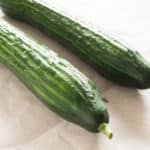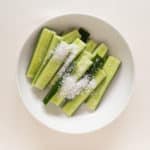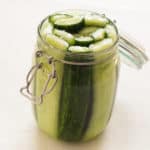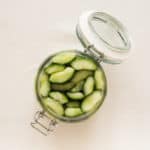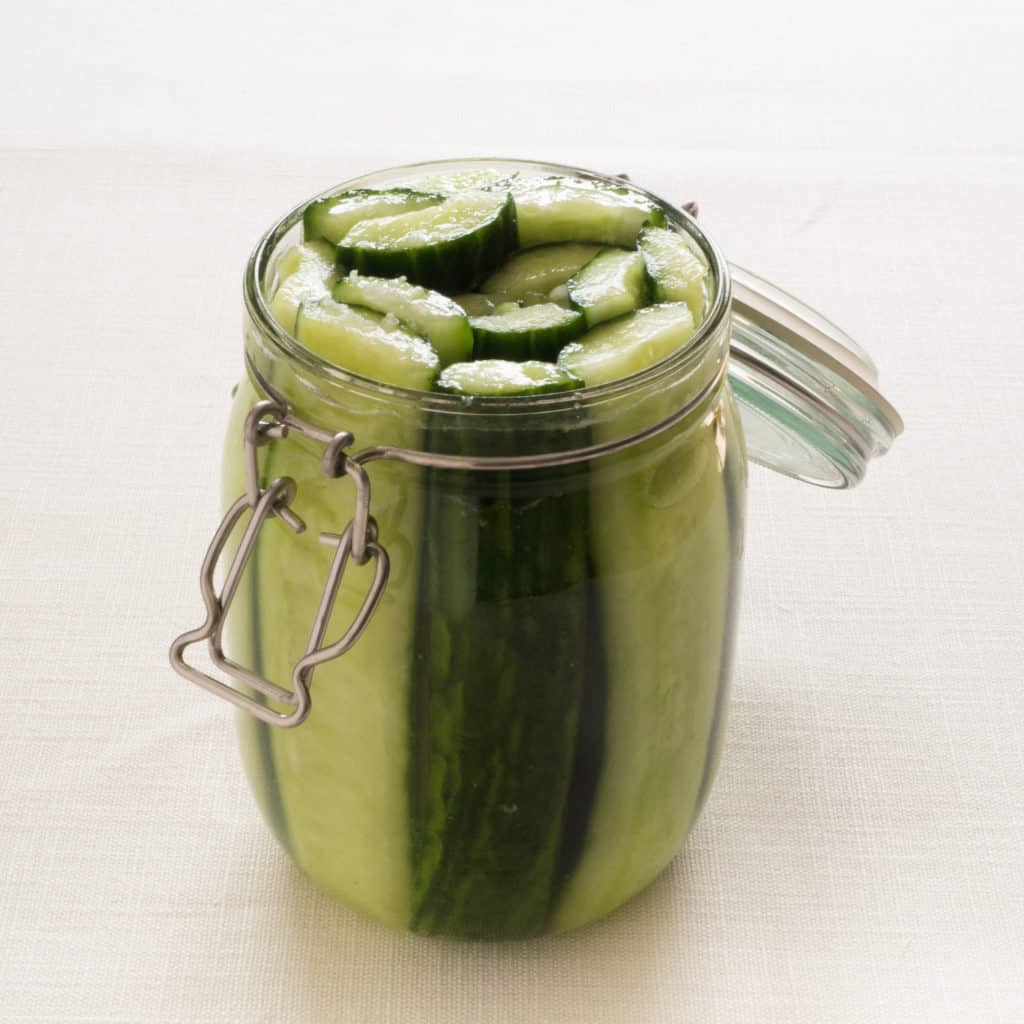
Preserved Cucumbers are amazing. I adore almost any type of fermented or pickled vegetable. September is the time to get pickling, preserving and fermenting. Cucumbers (go for local – they taste better) are still wonderful in September, but they are coming to the end of the season, so to enjoy them through the winter and into next year get preserving.
Preserved Cucumber is easy and quick to make but you must ensure jars a properly sterilised.
You can find the full Preserved Cucumber recipe here.
Perfect for a light snack, in sandwiches, as a side with almost any type of food from Vietnamese to buffets. Serve with Vietnamese Summer Rolls, Garlic-Free Houmous , Gluten Free Vegan Rosemary and Sea Salt Crackers or as a side to a substantial salad such as Winter Vegetable Salad With Walnut Dressing
Preserved Cucumber is celery free, coconut free, garlic free, gluten free, lupin free, mustard free, onion free, peanut free, sesame free, soya free, tree nut free, vegan.
There are lots and lots of fermenting and pickle recipes around and you may well have a great, family recipe. I like this recipe for its simplicity of ingredients and method. If you want to know more about fermenting and preserving I can highly recommend The Art of Fermentation* by Sandor Ellix Katz. A wonderful book packed full of knowledge, passion and information (but not recipes as we traditionally know them). This book is my inspiration to try out different methods of preserving on the whole world of fruits and vegetables.
Top tip. Sterilise jars in the dishwasher and be careful when removing the jars from the dishwasher and handling them not to touch the inside of the jars to keep them sterile. You must make sure everything is scrupulously clean; utensils, chopping boards, hands and so on. Any dirt, soap or grease may inhibit the fermentation process.
Do remember that any form of fermentation will release gas – you MUST ensure that your jars have some way of releasing gas. You can either cover the jars loosely to allow gas to escape (but germs not to enter – e.g. with muslin) or release the gas several times a day (which, if you choose this method, you must be rigorous about this).
Whilst Preserved Cucumber will store for months cucumbers tend to get softer the longer they are stored. You can enjoy Preserved Cucumber from just a few days after storing.
You can apply this technique to almost any vegetable (darker greens tend to be more… pungent… perhaps an acquired taste). Root vegetables tend to ferment well (carrot and radishes in particular) and I adore preserved cauliflower. You can also add herbs and spices to your taste, dill, chillies etc. Experiment and see what works for you.
*Affiliate link
Preparation
Difficulty easy
Preparation time 30 minutes
Cooking time 0 minutes (or about 10 days till ready to eat!)
You can find the full Preserved Cucumber recipe here.
Allergens
Preserved Cucumbers are gluten-free and vegan as well as…
Celery free
Coconut free
Garlic free
Lupin free
Mustard free
Nightshade free
Onion free
Peanut free
Sesame free
Soya free
Tree nut free
What’s the Deal with Cucumbers?
I have a thing about cucumbers that are not in-season in the UK. I never buy cucumbers that are not in-season or grown in the UK. Cucumbers grown out of season or outside of the UK (and imported to the UK) usually taste revolting. They taste of fish. I assume that is because they are grown in hot houses with lots of fish and bone meal, and because they have such a high water content, they taste of the horrendous ‘fertiliser’. Buying organic doesn’t solve this problem as organic food also uses animal origin-fertilisers. So I only buy seasonal UK produced cucumbers. I guess because they are seasonal they need less fertiliser and grow without being forced. It is pretty much impossible to buy produce grown without animal origin fertilisers but seasonal, as local as possible, produce tastes better…
The cucumber plant
Cucumbers (Cucumis sativus) are members of the gourd family, Cucurbitaceae. (Gourds include pumpkin and squash). The cucumber plant is a creeping vine that bears fruits (cucumber) that are used as vegetables.
Origin and spread of cucumbers
The cucumber originated in India, where a lots of varieties have been recorded. The cucumber has been cultivated for at least 3000 years and it is likely that the cucumber was spread across Europe by the Greeks or Romans. Records of cucumber cultivation appear in France in the ninth century, England in the 14th century and in North America by the mid-16th century.
There was a strange movement in Europe in the 17th century were it was thought that raw fruits and vegetables were bad for you. As cucumber did not stand up to cooking it was predominantly fed to cattle. It is said that this practice of feeding cucumbers to cows coined the modern name ‘cow cumber’. I have no idea if that is true or a convenient and interesting retelling of history.
Types of cucumber
There are lots of different types of cucumber, most notably seedless, hothouse or English cucumber (which is the predominant cucumber here in the UK) is longer than other varieties with edible skin and seeds. Although it is described as seedless it does have seeds but they are soft and edible. Other types of cucumber are predominant in the rest of Europe and the US. This type is shorter, has thick knobbly skin you need to peel and the seeds are usually inedible.
What do you do with cucumbers?
Cucumber is popular across all continents and cuisines and can be used in a wide variety of ways from chilled cucumber soup, to pickles, to brined, to classic cucumber sandwiches and more. Cucumbers can be cooked though with a high water content they will break down quickly if cooked for too long.
Nutritional value of cucumbers
Raw unpeeled cucumber consists of 95% water. 100 grams of raw cucumber provides 16 kilo-calories and provides minimal levels of essential nutrients. Cucumber is notable only for vitamin K which provides approximately 16% RDA.
